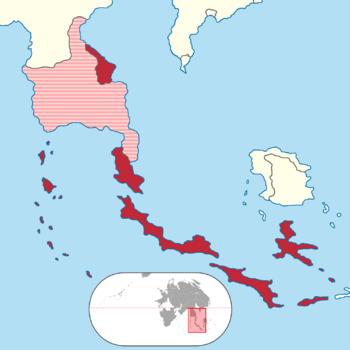Federated Melasian States
Federated Melasian States Föderierte Melasische Staaten | |||||||||||
|---|---|---|---|---|---|---|---|---|---|---|---|
| 1904 - 1919 | |||||||||||
Motto: "Stärke und Einheit" "Stength and Unity" | |||||||||||
 Melasia in 1910 | |||||||||||
| Status | Federal protectorate of the Mascyllary Kingdom | ||||||||||
| Capital | Jurgenshafen | ||||||||||
| Common languages | Hesurian | ||||||||||
| Religion | Semitarism | ||||||||||
| Monarch | |||||||||||
• 1904 - 1919 | Ludwig I | ||||||||||
| Governor-General | |||||||||||
• 1904 - 1912 (first) | Wilhelm von der Groeben | ||||||||||
• 1916 - 1919 (last) | Friedrich Leo von Hohenlohe | ||||||||||
| Legislature | Parliament | ||||||||||
| Senate | |||||||||||
| Council of States | |||||||||||
| Historical era | Colonial rule | ||||||||||
• Federated | 31 January 1904 | ||||||||||
• Fleicher accord | 13 May 1919 | ||||||||||
| Area | |||||||||||
| 1905 | 1,228,267.1 km2 (474,236.6 sq mi) | ||||||||||
| Population | |||||||||||
• 1905 | 3,842,950 | ||||||||||
| Currency | Mascyllary gold mark (1904 - 1907) Melasian frank until 1919 | ||||||||||
| |||||||||||
| Today part of | |||||||||||
The Federated Melasian States (Hesurian: Föderierte Melasische Staaten) is the name of a federation of 36 protected states in Southeast Pamira and Melasia, that existed between 1904 and 1919. The state was formed as a successor to the Mascyllary colonial administration of Melasia and comprised all 24 former princely states and three direct-rule states of the so-called Empire of Melasia. The state was formed in 1904 after the Melasian Uprising in 1901-1903 and the resulting reorganization of the colonial rule in the area. Despite formally receiving a degree of autonomy within the Kingdom, the federation was still heavily dependent on its former metropole, as it could not sign trade agreements, declare war or even possess its own armed forces and a command structure, and the Governor-General of Melasia served as de-facto head of state of the federation.
Before the formation of the federation, the Melasian colonial possessions of Mascylla were administered as a separate realm that shared a head of state with the Mascyllary Kingdom and consisted of three states directly controlled by Mascylla and 24 feudal states ruled by indigenous rulers. Formally, the country was called the Empire of Melasia, with the monarch of Mascylla bearing the separate title Emperor of Melasia. The Mascyllary head of state ruled the country via a viceroy, known as the Viceroy of Mascyllary Melasia. This status gave the state the ability to perform on the international arena separately from its formal metropole. Despite its autonomy, however, the state gave very little representation to most of its native peoples. The princely states, despite being based on feudal formations that were present before the Mascyllary colonization, were often very diverse, and as a result tended to be very unstable.
Following a number of attempts of the Mascyllary metropole to enact social reforms in the country via the Viceroy of Melasia, a wave of public unrest escalated into a full-scale uprising, known as the Melasian Uprising of 1901-1903. The main outcome of the uprising was the full reorganization of the country: the former colonial institutions were liquidated on par with the feudal system of princely states; the country was separated into 36 states that represented the ethnic diversity of Melasia. The country received its first constitution and a bicameral parliament, and its status was changed to a protectorate of the Mascyllary Kingdom. The Federated Melasian States participated in the Great war on the side of the Armala Coalition together with Mascylla, and Melasian soldiers fought on every front on which Mascyllary troops were present.
After the Great war, the country experienced another wave of nationalistic uprisings, this time started and actively supported by its own ruling class as an attempt to increase the country's autonomy from Mascylla. After 3 years of protests and engagements between 1916 and 1919, the country signed the Fleicher Accord with Mascylla, further increasing its autonomy, and restructuring itself into an unitary republic. Formally, this accord gave the country complete independence from Mascylla, with the federal structure and the last Mascyllary institutes being disbanded in 1919.
Part of a series on the |
||||||||||||||||
|---|---|---|---|---|---|---|---|---|---|---|---|---|---|---|---|---|
| History of Melasia | ||||||||||||||||
  | ||||||||||||||||
|
||||||||||||||||
| Timeline | ||||||||||||||||
History
Background
Mascyllary expansion in Melasia
Formation of the Federated Melasian States
Dissolution and outcome

